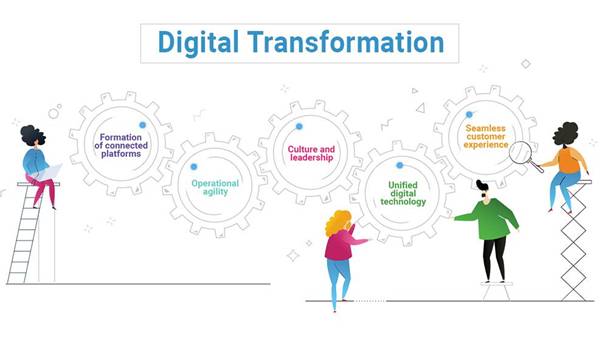Talking about Digital transformation, it is the organizational, cultural, and operational change of an organization, industry or even that of ecosystem through a smart integration of digital technologies, procedures, and competencies across all sorts of levels and functions in a staged and planned way.
When you talk about What is digital transformation, you should know that digital transformation (even DX or DT) leverages technologies to form up value and new services for diverse stakeholders (customers in the widest possible sense), innovate and accomplish the capabilities to quickly adapt to changing circumstances.
Though digital transformation is mainly used in a business context, it even influences other organizations like that of governments, that of public sector agencies and organizations which are involved in tackling societal challenges like that of pollution and aging populations by leveraging one or more of these current and emerging technologies.
Remember that the digital transformation is not simply about disruption or technology. It is also about value, people, optimization and even the capability to quickly adapt when such is required through an intelligent use of technologies and that of information.

In simple words, digital transformation is the profound and smooth transformation of business and organizational activities, competencies, processes, and models to completely leverage the changes and opportunities of a blend of digital technologies and their accelerating impact across society in a planned and prioritized way, with current and future shifts in mind.
The growth of new competencies revolves around the volumes to be more agile, people-oriented, creative , customer-centric, streamlined, efficient and able to persuade/leverage opportunities to change the status quo and tap into big data and new, increasingly formless data sources and service-driven revenues, with the Internet of Things as a crucial enabler. Digital transformation efforts and strategies are mostly more urgent and present in markets with a higher level of commoditization.
Current and future shifts and changes, heading to the necessity of a faster deployment of a digital transformation strategy, may get induced by several causes, often at the same time, on the degrees of customer behavior and that of expectations, fresh economic realities, societal shifts (e.g., Aging populations), industry/ ecosystem disruption and (the hurrying adoption and innovation regarding) emerging or present day digital technologies.
Furthermore, in practice, end-to-end customer experience optimization, then that of operational flexibility and innovation are main type of drivers and aims of digital transformation, coupled with the development of new revenue sources and information-powered ecosystems of value, heading to business model transformations and fresh forms of digital processes. However, before getting there it is the main ingredient to solve internal challenges as well, amidst others on the degree of legacy systems and disconnects in procedures , whereby internal goals are unavoidable for the next steps.
It is a Journey for You
Digital transformation is a proper journey with multiple connected intermediary goals, in the end, going towards omnipresent optimization across processes, divisions and the business ecosystem of that of a hyper-connected age were constructing the right bridges (between front end and back office, information from ‘things and decisions, folks , teams, technologies, diverse players in ecosystems etc.) In function of that journey is main ingredient of success.
Here, the human component is key in it on all levels: in the stages of transformation as such (ecosystems, collaboration, skills, culture, empowerment etc.) And clearly in the aims of digital transformation. Since people do not really wish ‘digital’ for everything and do value human and face-to-face type of interactions there will always be an ‘offline’ element, relying on the context. Yet, also in non-digital interactions and transactions digital transformation plays a role in the sense of authorizing any customer-facing agent and that of worker.
Role of Strategy
The aim of a digital transformation strategy is to form up the capabilities of fully leveraging the possibilities and chances of new technologies and their influence quicker , better and in more innovative way in the future. A digital transformation journey requires a staged approach with a clear roadmap, encompassing a diversity of stakeholders, beyond silos and that of any sort of internal/external limitations. Such a roadmap considers that end goals will go on to move as digital transformation genuine is an ongoing journey, as is alteration and digital innovation.
Conclusion
To sum up, if you want to grow and expand your business in the present time then you need to embrace digital transformation. In the absence of this transformation, your business is bound to doom.